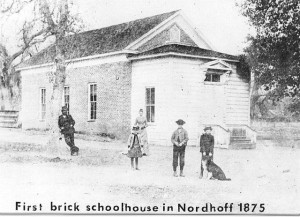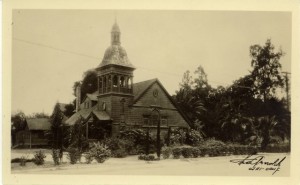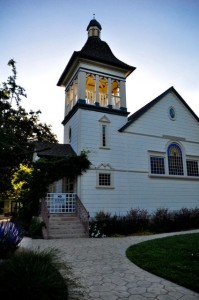Discord Comes to the Ojai Valley by John Montgomery
[Note: John Montgomery was one of Ojai’s first settlers. He arrived in Ojai in 1874. He lived in the large, two-story wooden house that still stands on Matilija Street, next to Theater 150. Montgomery Street is named after him.]
From the year 1873 to 1879 we were a harmonious and model community, living in peace and good fellowship, with no offensive inequalities of fortune or education. Upper and Lower Valley, East End and West End mingled on equal footing at our picnics, May Day parties, and Christmas trees. Our population continued increasing, and the newcomers were welcomed to our festivities. Those were happy days for our children who knew no strifes but a generous emulation at school; many of them are now fathers and mothers residing in the valley, some have left to return, and a few have gone never to visit us again.

Our little brick school house sheltered on Sundays members of all churches and creed, and many were ignorant and indifferent as to the pastor’s sect or denomination, enough that he preached good will and the golden rule to all men. The stentorian voice of our village blacksmith led the choir at service, and, admitting that he did sing out of tune a half note on either side of the scale was a trifle in those days to the neighborly ear of charity, and was compensated by the fervor of his good intentions.
For years we were content to ride in our farm and spring wagons, and our cottage organs were the pride of the parlor and had the choice location among the furniture.
But this Arcadian felicity was not to last forever, and the demon of discord was biding his time to entrap us. First, a top buggy came into the Valley and the wagon fell fifty points. Then Mrs. _____ introduced with her two accomplished daughters, a seven octave Steinway grand, and the organ trade disorganized to a collapse. Later, a reading club was got up in the village, having a clause to avoid crowding, that members must reside in Nordhoff. This was equal to slamming the door in people’s faces, and the epithets “stuck up” and “high-toned,” were hurled back in retributive ejaculations.
The fact is, people were soured. The year 1877 was a dry one, and 1875 was the disastrous “rust” year, and two bad years in succession made people “long” on expense and “short” on resources. The hotels were crowded with stylish eastern tourists who introduced new and expensive notions, sneered at our music and church service, and reproached us on our want of a decent church. The two hotels, though miles apart, glared at each other in envious rivalry. [The Nordhoff Hotel was located where the Libbey fountain is now; Oak Glen Cottages were located on the corner of Ojai Avenue and Gridley.] The guests and others at the Nordhoff Hotel raised a subscription to build a church, and the whole Valley joined in the contribution; trustees were chosen and the association incorporated, and all went harmoniously till the question of the church site came up. Then the storm burst. Nordhoff people insisted on having the church in their town, while the outsiders were equally determined to have it up their way, and complete rupture took place between Nordhoff and its opponents; and the village, strong in the justice of its course, put on its war trappings and defied the world.
The Upper Valley to a man joined the eastern seceeders. The two hotels were the

nucleus of the hostile forces. The good pastor was drawn into the vortex of dissension, and losing his equilibrium, recklessly declared for the Wild West, and was thrown overboard by the “Orientals” as a second Jonah. Then suddenly somebody discovered that the minister was not a Baptist, and another that he was not a Methodist; while some of the older members had their doubts that he ever was sound on Calvanism. But the difficulty deciding on a church site had to be overcome one way or another; and the trustees, amid the din of battle, resolved, four to one, that the proper place for the Presbyterian church was where it now stands, in the center of the community and accessible to all [where Ojai fire station is now located]. Nordhoff was furious, the more so that one of its trustees had gone back on it, voting with the majority; and this culprit has survived the crisis to indite to The

Recurrent these “Annals of the ‘parish’.” But the plucky town kept its back up, and when Mr. S.S. Smith of San Francisco, generously contributed $500 toward building a chapel, Nordhoff immediately made up the difference and never rested till the last coat of paint was on the walls and a sonorous bell in the steeple [this second church was built where the Ojai Library is now located in downtown Ojai].
After this little blizzard the social atmosphere cleared up; Christian charity that for a time had not a leg to stand on, now threw away its crutches, and asserted its supremacy, softening men’s hearts and extending the right hand of fellowship. But never again will the valley enjoy the primitive simplicity of its earlier years, when it was a model community, realizing the dream of a Roussen or a Tolsten.
Note: When Mr. and Mrs. Charles Nordhoff visited the Ojai Valley in 1881, Mrs.

Nordhoff decided the community should have a proper church. She sent plans for a church along with the money to build it. It was constructed on the Soule property, where the fire station now stands. Those living in the town of Nordhoff defected and built their own Congregational Church where the Ojai Library is located. In 1900 the two congregations reunited and their churches were moved to the same lot-the parking lot in front of Jersey Mike’s. The original Presbyterian Church served as the church, and the Congregational Church was used for Sunday school classes and offices. When the current Presbyterian Church was built on Foothill Road, the old Presbyterian Church was sold to the Nazarenes and moved to the corner of Montgomery Street and Aliso Street. It is now a center for author Byron Katie and is Ojai Historic Landmark #1.]

But…. at the time that Mr. Montgomery owned the house, it was a small one-story wooden house, the next family, the Bakers, added the second story and all of the other rooms (the Bakers added another room with each new child).
Is this not the same house Mr. Clausen originally had the mortuary in?